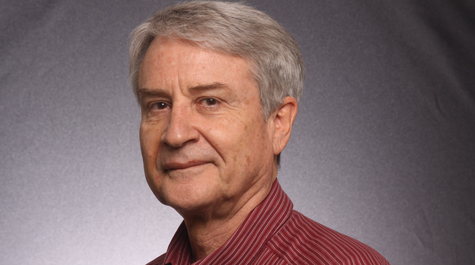Eric Bradley, four-time department chair, wins Shirley Aceto Award
If universities recorded faculty service by punching a card, Eric Bradley’s card wouldn’t have room for any more holes.
Bradley is a professor in William & Mary’s Department of Biology. He is this year’s recipient of William & Mary’s Shirley Aceto Award. Established in 2010, the award honors “a member of the instructional or professional faculty who demonstrates an exceptional commitment to excellence in service to the campus community,” according to the award website.
“I am very honored to receive this award. I care deeply about our students, staff and faculty, and for that reason I’ve dedicated a major part of my professional activity to making William and Mary a first-rate institution,” Bradley said. “Part of my effort over the years has been to ensure that our teaching and research facilities are state-of-the art, safe and well maintained. I’m most gratified to learn that others have appreciated my efforts.”
At present, Bradley serves as chair of the biology department; it’s his second term. He has also chaired two other academic departments—mathematics and applied science—during his time at the university.
“I believe that he is unique on campus in the number of different departments in which he has served as chair. He is unusual, if not unique, in the number of years he has served as a chair,” Paul D. Heideman wrote.
Heideman, the Boles-Ash Distinguished Professor of Biology, made the comment in a letter supporting Christopher Del Negro’s nomination of Bradley for the Aceto Award.
Heideman arrived at William & Mary during Bradley’s first term as biology chair, and his letter acknowledges the assistance he received in getting started in the department.
“Dr. Bradley was quick to respond to questions, and went far beyond what I felt was necessary in helping me deal with problems setting up my research laboratory and teaching laboratory,” Heideman writes. “Ten years later, when I became a department chair, I often thought back to Eric’s tenure as chair. I tried to emulate his example in many ways, but particularly in mentoring new faculty members.”
Heideman also credits Bradley with being the father of what we now know as the Integrated Science Center. Heideman writes that during his own term as chair, there was a great deal of concern about evolving plans for the renovation of Millington and Rogers halls.
“Dr. Bradley had the great idea to combine the two single projects into one new project,” Heideman wrote. “This was something no one else had considered. Just as importantly, Dr. Bradley had the technical know-how to convince others in attendance that the combination was feasible.”
Del Negro, the incumbent chair of the Department of Applied Science, joined the department in 2003 when Bradley was chair of that department. Like Heideman’s, Del Negro’s nomination letter cites numerous examples of assistance from Bradley. Del Negro also notes Bradley’s work ethic and hands-on approach to solving problems.
“He does not just make phone calls to get things done; Eric does them!,” Del Negro wrote. “I have been present when Professor Bradley takes apart door locks and fixes them, performs minor electrical work, tests card-swipe locking systems, as well as performs routine training on equipment from cryostats (a tissue-slicing device in biology) to ultra-fast Ti:sapphire lasers (used in physics and neuroscience research). ”
Bradley’s service is recognized beyond the university’s science buildings. Brian Kreydatus, associate professor in the Department of Art and Art History, cited Bradley’s role as Arts & Sciences emergency and planning coordinator, “or as we referred to him with admiration, ‘buildings tsar.’”
In his letter of support, Kreydatus outlined a couple of incidents in which the building tsar came through in a big way. He credited Bradley’s advice and guidance as instrumental to the department maximizing results of renovations to Andrews Hall. In another instance, Bradley got involved in a renovation project at the Lake Matoaka Fine Arts Studio.
“The Matoaka renovation seemed like a simple roof repair and without Eric that's all that would have happened,” Kreydatus wrote. “Due to his diligence, frequent on-site visits with facilities and external contractors, it was discovered that most of the joists in the north end of the building were rotten, creating an appallingly dangerous situation.”
Bradley even got endorsement from the university’s Department of Facilities Management. Dave Shepard, associate vice president, noted that he has worked with Bradley for a number of years, “sharing both good and bad times.
“He is demanding of Facilities Management, holding us accountable for improving our services to the College. However, he is also practical and understanding of the constraints that FM must work with,” Shepard wrote. “I can think of very few people on campus who combine his insight, professional demeanor, understanding and relentless pursuit of service to Arts & Sciences.”
Bradley came to William & Mary in 1971. In addition to his impressive slate of service to the university, he has taught a number of classes and maintains an active research lab.
















